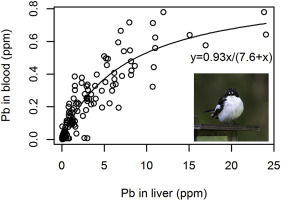Environmental Pollution ( IF 8.9 ) Pub Date : 2017-10-16 , DOI: 10.1016/j.envpol.2017.10.031 Åsa M.M. Berglund

|
Birds are widely used to assess metal contamination in the environment and there are different approaches to determine the exposure level in individuals, some being destructive (collection of soft tissues) and some non-destructive (blood, feathers and excrement). The use of blood to detect internal concentrations of metals is an acknowledged method, but to what extent blood can predict the concentrations in soft tissues has been less well evaluated in wild terrestrial birds. The same is true for excrements. This study compares the non-destructive methods using blood and excrement with liver sampling, with respect to exposure and accumulation of the elements arsenic, cadmium, copper, lead and zinc in nestling pied flycatchers (Ficedula hypoleuca). Blood, liver and excrement reflected the environmental exposure of non-essential elements and were independent of nestling sex. There were asymptotic relationships between the concentration of arsenic, cadmium and lead in liver and blood, excrement and liver, and excrement and blood, but none for copper or zinc. Those relationships were generally stronger between liver and blood than between excrements and internal concentrations. Lead had the strongest associations for all matrixes. The conclusion is that blood is an appropriate tool to assess accumulation of arsenic, cadmium and especially lead, but that blood can underestimate the accumulation at highly contaminated sites. Excrement can also give an indication of metal accumulation, but may overestimate internal concentrations at high exposure, and individual variability makes direct comparisons between these matrices less appropriate.
中文翻译:

评价血液和排泄物作为鸟类金属累积的生物指标
鸟类广泛用于评估环境中的金属污染,并且有不同的方法来确定个体的暴露水平,其中一些具有破坏性(收集软组织),而一些则没有破坏性(血液,羽毛和粪便)。使用血液检测金属内部浓度是公认的方法,但是在野生陆生鸟类中对血液可以预测软组织中的浓度的预测程度较差。粪便也是如此。这项研究比较了使用血液和粪便与肝脏采样的无损检测方法,就雏鸟捕蝇器(Ficedula hypoleuca)中砷,镉,铜,铅和锌元素的暴露和积累进行了比较。)。血液,肝脏和排泄物反映了环境中非必需元素的暴露,并且与雏鸟的性行为无关。肝脏和血液中的砷,镉和铅的浓度,排泄物和肝脏以及排泄物和血液之间存在渐近关系,而铜或锌则没有关系。肝脏和血液之间的这些关系通常比排泄物和内部浓度之间的关系更强。铅对所有矩阵的关联最强。结论是,血液是评估砷,镉(尤其是铅)积累的合适工具,但血液会低估高度污染部位的积累。排泄物还可以指示金属的积累,但在高暴露量下可能会高估内部浓度,



























 京公网安备 11010802027423号
京公网安备 11010802027423号